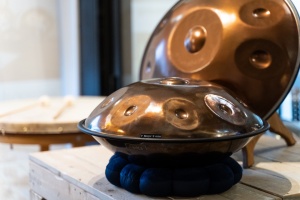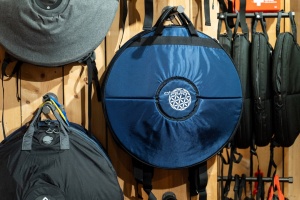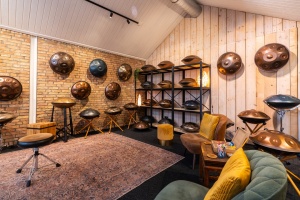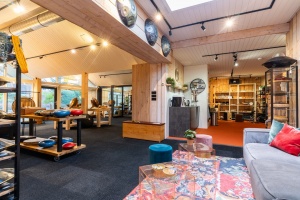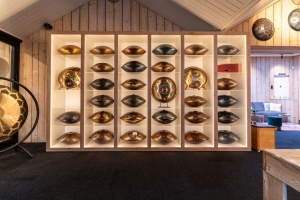How can I choose the best handpan drum for me?
Which handpan should I buy?
You will find an enormous diversity of handpans. The best way to make a choice is to play various handpans, but also listen to several handpans. Each instrument is slightly different and has its own unique character. To choose a handpan just based on videos, has the disadvantage that timbre and resonance usually doesn’t sound as good as when you hear it live. First of all because it is difficult to realistically record the sound of a handpan. The result depends on the acoustics of the recording room and the microphones that was used. In addition, the device you use to listen to a recording also has an influence on the sound. So, if you want to listen to a handpan online, we advise to use good headphones or speakers. The speaker of a telephone, or even a computer, does not reproduce the sounds of a handpan properly.
We developed our own special orientation sessions. An extensive form of buying guidance giving you the opportunity to try different handpans in a very calm and relaxed environment. An experienced handpan player helps you to make a good choice by giving proper advice. It is also possible he plays several handpans so you can totally focus on the sound.
If you would like to do some preliminary research or want to know more about handpans, you will find a lot of information below. This will help you determine your final choice.
- Ways how to choose
- Root notes and scales
- Quality
- Types of metals used for handpan drums
- Number of notes (pads)
- Useful tips for buying handpan drums
- Spacedrum®, tongue drums, steel drum, Hang, hang drum, hand drum... what's the difference?
Google review: (Google Translated from Dutch)
Guus Pluk: “I bought a handpan at the end of September. The communication beforehand was nice. Clear agreements in advance. I came to HandPanShop.nl especially for the 1 on 1 guidance, in combination with the wide range of various pans. The warm welcome and the time for a nice conversation also ensured a warm landing. As well as taking the extensive time to explore the various pans and sounds. First by Henk-Jan, later I was allowed to go myself. Superior is the overall attitude towards buying a pan. No sales pitches, no time pressure. Pure attention and love for the product. A holistic approach. Wherever you come from, this place is highly recommended. Even if you decide (yet or not) not to come to a head after a session, you will have gained a lot of knowledge and insight for the possible. buy a pan later.”
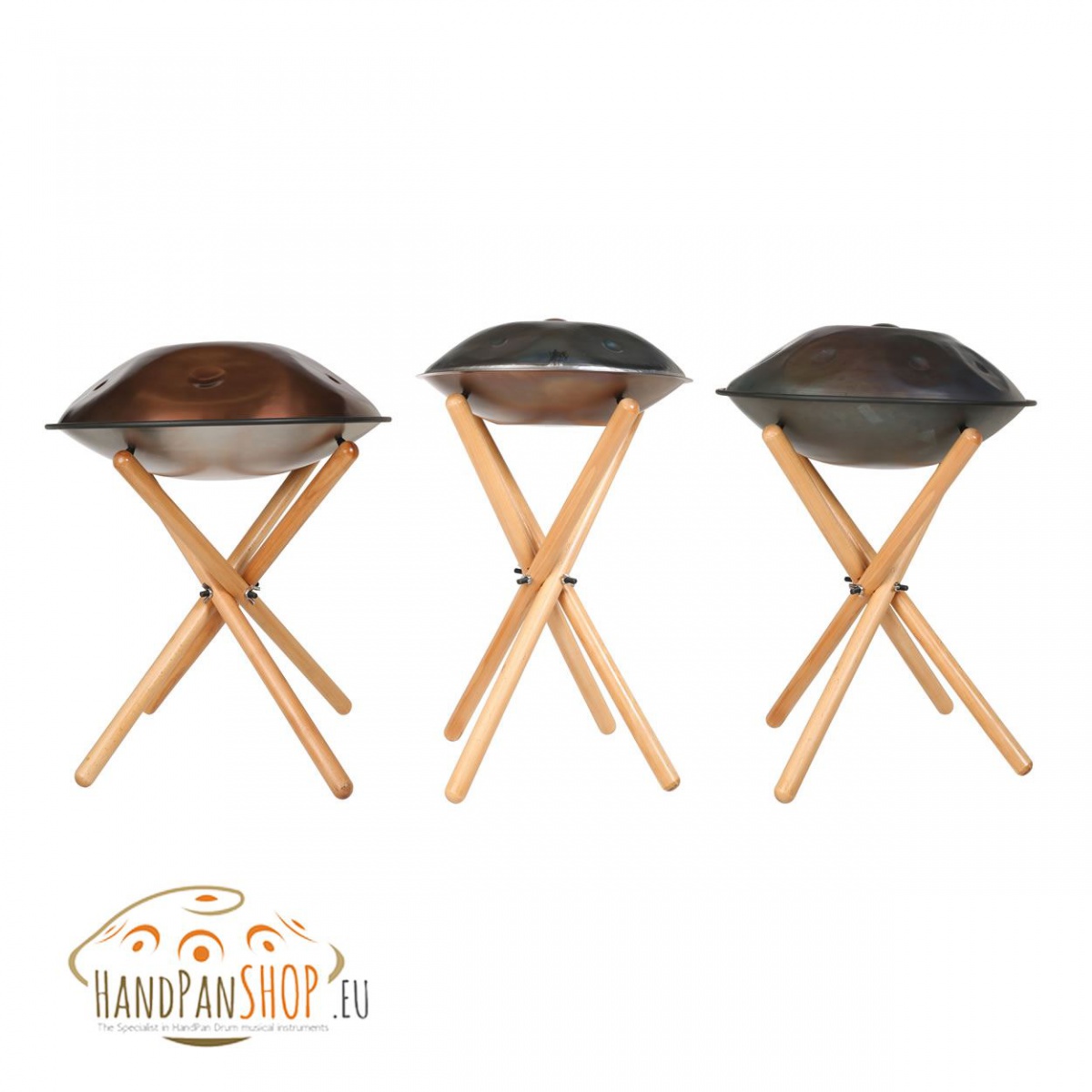
Ways how to choose
How do I choose a handpan, is a frequently asked question, because there are so many different handpans for sale. Before we take a look at the quality, scales and used material, we will start with informing you about the ways you can make a choice out of the wide variety of available handpans.
Physically present to make a choice
As mentioned earlier, the best way to make a choice is to play and listen to the various handpans yourself. During our orientation session, together we will find the handpan that perfectly matches your style in terms of scale, timbre and resonance. In your presence, we play many handpan drums that differ in scales, metals and manufacturers. We take our time for these sessions, because every scale has a different atmosphere; from cheerful to melancholic as well as from earthy to mystical.
In this way, it gradually becomes clear what your style and preference is. In our experience, this is the best way to buy an instrument that you actually will continue to play, even when the 'new smell' has worn off. Another reason why we pay a lot of attention to these orientation sessions is that we have experienced that customers often buy a different handpan than they had initially planned!
Google review: (Google Translated from Dutch)
Vienna Mollers: “I had ordered a certain handpan online, but I read that some people went home with a completely different one than they had initially bought, so I was very open about it and was surprised ... Good thing too, because the handpan I liked the most was completely different, both the brand and material as well as the mood and key! It was also 150 euros cheaper, so that's a bonus. Extensive time was taken for me (I was supposed to receive a free workshop of one and a half hours with my purchase, but I was there for 2 hours. I am very happy with my handpan and the service, thank you very much!!!"
Make the choice online
In our webshop you can watch videos and listen to many of the available handpans. As mentioned, we do not recommend this approach. It has the disadvantage that timbre and resonance usually doesn’t sound as good on stereo equipment as when you hear it live. But it is a good way to do some preliminary work.
Below we discuss the characteristics of handpans. Those will determine your final choice.
Root notes and scales
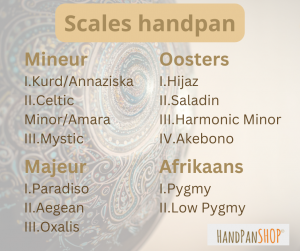 The scale defines the atmosphere of the sound. And that atmosphere is very diverse. There are so many scales: cheerful, dreamy, meditative, lively, exotic, etc.
The scale defines the atmosphere of the sound. And that atmosphere is very diverse. There are so many scales: cheerful, dreamy, meditative, lively, exotic, etc.
The scale is determined by the combination of the different tones that can be created with your handpan. Your choice of handpan starts with deciding the roto note. This can range from F2 (a very low and deep tone) to a G3 (a high and sparkling tone). The different tones already making a clear difference in the sound.
The handpan is tuned based on the chosen root tone. The way in which the tuning is built up determines the final scale. These can be divided into minor, major, Eastern and African. Within these categories there are further options. Below we tell you more about a large number of scales.
PLEASE NOTE: The cheapest handpans often don't have the tuning that appeals to most people and frequently have a limited number of tone fields. Most people find the sound of a D-minor handpan with nine tone fields the most beautiful.
Scale minor handpan
Minor is the most common scale in handpans. Minor is known for its open character. You are able to play in a way that the sounds resonate a bit more melancholic, but you can just as easily create a more cheerful character. This makes minor a nice and diverse scale with a lot of musical potential.
I. Kurd/Annaziska: This is the most neutral form of minor. The tone structure corresponds to the minor scale as you would learn playing the piano, for example. It is a nice compact tone structure, with many harmonic possibilities. If the root tone is C or C#, it is called ‘Annaziska’. In all other root tones it is called ‘Kurd’.
II. Celtic Minor/Amara: This scale has a slightly wider range than the Kurd/Annaziska. For this, one note of the scale has been skipped, which is the sixth note in the minor scale. This choice leads to a nice balance between low and high notes. A fine scale for the player who wants to play both harmonically and melodically. If the root note is a C or C#, it is called Amara. In all other root notes it is called Celtic Minor.
III. Mystic: This is a minor variety with the widest range. The notes are mainly chosen around the root note of the instrument. This provides you with a quiet and calm sound, with less emphasis on harmonic complexity and more on a homogeneous atmosphere. Mystic is a fine tuning for the player who wants to play mainly melodically and wants to focus more on atmosphere.
Scale major handpan
Major is generally known for its more cheerful, happy character. In combination with a handpan, which already has a lovely character on its own, this results in a very peaceful and calm sound.
I. Paradiso: This is a nice open scale with a fine balance between the lower and the higher notes of the major scale. Paradiso is a pleasant and neutral representation of handpans with a major scale. Suitable for the player who wants to create a peaceful atmosphere, playing both harmonically and melodically.
II. Aegean: This is a Lydian scale. It focusses a bit more on the lower notes. In combination with the Lydian character, the result is a beautiful dreamy and warm sound. There's something mysterious about Lydian as well. This scale is suitable for any player who wants to explore the dreamy side of this beautiful instrument in addition to regular playing.
III. Oxalis: Oxalis is a variation of major that focuses more on the ‘high end’. It's a sparkling, fresh sound that brings on a cheerful character. Oxalis is especially suitable for the player who is looking for a mood with cheerful, light-hearted atmospheres. This scale rarely occurs.
Scale oriental handpan
In addition to major and minor - the benchmark in Western music - also scales exist that were originated in other cultures. For example, from the Middle East or Asia.
I. Hijaz: Named after a region in Saudi Arabia, this scale has a Middle Eastern character. The phrygian structure creates a mystical and atmospheric sound with a strong oriental character.
II. Saladin: This scale is named after a Syrian general. This scale is similar to the Hijaz, but focuses more on the higher tones. Like Hijaz, it has a mystical and atmospheric sound, but due to the higher tones it is slightly easy-listening and more lilting.
III. Harmonic Minor: This scale can be placed in the middle between the western minor and the eastern Hijaz/Saladin sound. It is a scale that showcases a Middle Eastern tinge, but this oriental tinge is less present than in other scales within the eastern segment.
IV. Akebono: Akebono is a scale with Japanese roots, named after a famous Sumo wrestler. It's a pentatonic scale, meaning that the five best appropriate notes have been chosen to shape this scale. Akebono gives an atmospheric sound with a typical Japanese character.
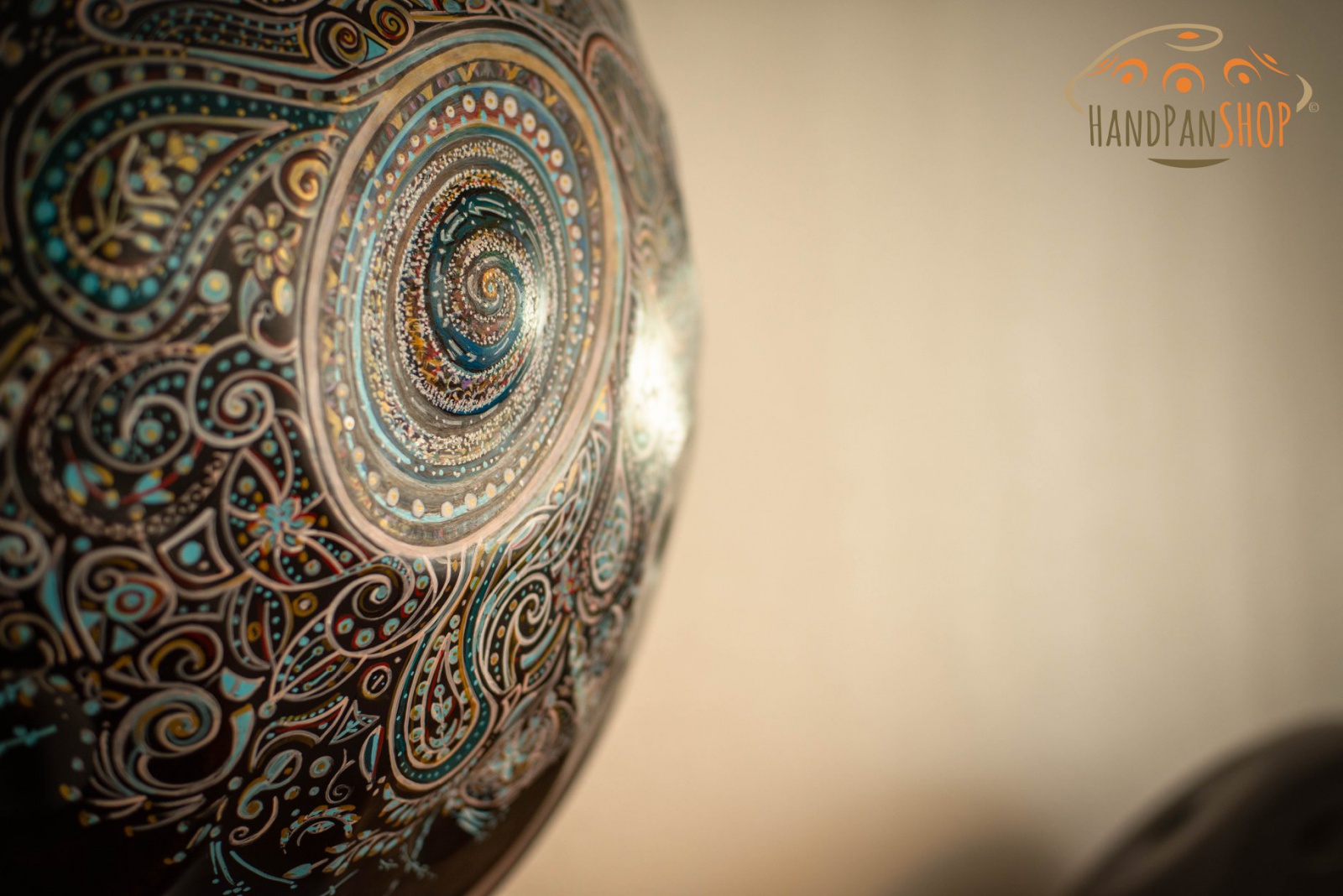
Scale African handpan
African music often consists of strong rhythmic patterns, in addition to harmony and melody.
A scale with an open character match well with this kind of sound. These scales are still relatively new within the world of handpans.
I. Pygmy: This tuning attracts attention because the handpan can be played in two scales. This gives the sound a more floating character, that makes you create different atmospheres quite easily. A pleasant and open scale for a playing style that allows you to go in any direction you want.
II. Low Pygmy: This scale is similar to Pygmy, but with the variation that the root note is lowered. This gives a more grounded and deeper character. The tones around the centre are the same as the Pygmy and this handpan provides you with the same floating, atmospheric character.
Quality
The quality of a handpan is determined by various factors. An important part of the quality is the material that was used and the way in which the individual note fields are tuned. Manufacturing a good handpan takes a lot of time. Usually, the number of hours the builder spent on the handpan translates back into the quality. If an experienced and talented manufacturer builds a handpan with passion and the best available materials, you own a masterpiece. Actually, it is comparable to a Michelin Star chef. If a talented, experienced cook uses mediocre ingredients, the meals will still be disappointing. The same goes for good ingredients, but used by an unexperienced cook. And what applies to both the cook and the handpan builder: passion and love are absolutely reflected in the end result.
Quality handpan builders deliver the most consistent output. With less experienced or less good builders, the quality of a handpan can vary greatly. Regardless of the quality though, has each handpan a unique character, because every hammer hit while tuning, changes the handpan a little bit.
Let's first take a look at the method of tuning.
Tuning
A handpan consists of note fields, each with its own pitch. For those who are interested: a note field contains a fundamental tone and two overtones (harmonics) in the ratio 1:2:3. The two overtones are called octave and fifth (or minor third).
The best handpans have note fields that are well isolated from each other. This is guaranteed by creating empty spaces. As a result, playing one note field does not activate another note field. This causes an unwanted interchange of both fields, called “crosstalk”. What makes a handpan unique is that when you strike a note field, the handpan as a whole resonates, but the specific field also has its own distinctive sound.
Next to unwanted interchange of two note fields, we also know intentional interchange.In that case, several notes share the same frequencies. This makes it possible to play one note and, at the same time, activate another note too. The combination of the two notes can sound very pleasant.
The above explains why there is a technical limit to the number of note fields on a handpan. Therefore, some manufacturers deliberately don’t fabricate handpans with more than nine or ten note fields. Although one or two extra note fields could have been added, the sound of the handpan often doesn't get any better.
Moreover, with a low tuned ding, the tonal surface is much larger than with a higher tuned ding. That is why, for example, at a B2 on a 53 cm handpan only eight fields fit next to the ding. Whereas at an E2, eleven tonal planes simply fit next to the E.
Types of metal used for handpan drums.
The type of metal provides the basis of a handpan and influences the sound. Depending on your wishes, you can therefore partly base your choice on the type of metal that was used to build the handpan.
Stainless steel handpans
Stainless steel is durable because it hardly rusts and is solid. Stainless steel has a bright timbre and longer reverberation. This creates a sparkling sound. This makes this metal extra suitable for playing more slow-paced atmospheres and creating a calming effect.
Ember steel handpans
This metal has been specially developed for handpans and provides a beautiful sound. Ember steel is a kind of stainless steel that differs slightly in terms of chemical and mechanical composition. This gives you a combination of a longer reverb with a bit more bass. This material is suitable for both more slow-paced atmospheric playing as well as more rhythmic playing in a medium tempo.
Note, that the different chemical composition reacts faster to fingers, dirt and moisture. If this isn’t cleaned regularly, stains will arise. The stains are purely optical and doesn’t affect the durability and/or sound of the handpan in any way. However, if you like a shiny and clean handpan, it is important to take this into consideration. In the long run, all ember steel handpans will discolour slightly anyway. It is very personal if you like this ‘patina or feel that stains are regrettable.
Nitrated steel handpans
The special treatment that the steel has had (nitration), leads to a specific sound that can be placed more towards the bass segment. This results in a pleasant deep and grounded sound. Nitrated steel has a medium reverberation. Sufficient to produce slow-paced sounds, but not too intrusive. It is perfect possible to also play in a faster pace. Suitable for multiple playing styles, handpans made from nitrated steel are a perfect choice for all-round players.
Blue steel or Raw steel handpans
Blue steel is the rawest type of metal used for fabricating a handpan. This metal hasn’t had any nitration or other treatments. After building, the handpan is heated in an oven or open fire. As a result, these pans colour beautifully blue in combination with a beautiful glow. Blue steel is therefore a pleasure for both eye and ear. Blue steel is known to have a slightly more percussive sound. This means that the reverberation has a short to medium duration, making it well suited for faster, rhythmic playing styles. But due to the available higher sounds, blue steel is also suitable for slow-paced playing. The sound is best described as honest and organic. Just like handpan drums made from nitrated steel, these also are a perfect fit for the all-round handpan player.
Most people prefer handpans made out of ember steel, stainless steel or nitrated steel. However, as HandPanShop we want to offer our customers the widest possible range.
Number of notes (pads)
Nowadays, the number of note field, also called pads, varies from eight to twenty.
Eight pads: Eight pads are not common anymore. The first Hang® had eight note fields, but the technical possibilities increased and the instruments are also slightly larger. That is why you mainly encounter nine pads or more.
Nine pads: The default is nine note fields. This means one tone on top of the handpan (the Ding) and eight tones around it. This is why it’s sometimes being indicated as “8+1”. With a handpan consisting of nine pads you can go in every direction. You are easily able to follow lessons or instructional videos. On these handpans, the note fields are normally located at the top.
Ten pads: Using higher note fields (C# and above) provides the handpan with space for extra note fields. Higher tones require smaller note fields. As a result, a ten-pad handpan has the same capabilities as a nine-pad handpan, but with one extra higher note for a wider melodic range. These handpans also have the note fields placed at the top.
Ten to twenty pads: More than ten pads are only possible for very high scales (E or higher). The higher the scale, the smaller the note fields, so more tones fit on the top of the handpan. These number of pads can also be achieved by adding note fields to the bottom of the handpan. There is space on the bottom for up to ten of these bottom pads. These note fields are often a combination of a few extra lower and higher notes. These are tuned in alignment to the tone structure on top of the handpan.
Bottom pads or not?
Bottom pads give more harmonic possibilities, but it requires a completely different, more technical way of playing. You also need more knowledge about which notes match together. Another important detail is that bottom tones will bring additional costs. It can be a wonderful addition for advanced players, though we recommend handpan beginners to start with only note fields. Unless they consciously want to purchase a handpan that gives them extra options, with regard to the future when they progressed to an advanced player.
Tip: Are you looking for a handpan for beginners? We recommend choosing at least eight note fields and preferably a maximum of nine (not including the root tone). In our experience, that is already enough of a challenge.
Useful tips for buying handpan drums
Take lessons
Are you planning to take handpan lessons? A lot of instruction videos use a D-Kurd handpan, so it can be practical to also choose a D-Kurd so that you can more easily replay these videos. (Link to ‘Learn to Play the Handpan’)
Costs
Whichever handpan you choose, choose one that sounds really nice to you. A handpan with a beautiful sound which plays comfortable, invites you to play more often, even when the 'new' has worn off. We do not recommend choosing a 'cheaper' handpan purely based on the costs. Our many years of experience show that such a handpan will eventually remain unused, because you don't like the sound.
Frequency 440hz or 432hz
Most western musical instruments are tuned in 440hz. This makes it easier to play together. However, it is also possible to tune a handpan in 432hz and 444hz, among other frequencies. You may consider, while making your choice, that interplay between a 440hz and a 432hz instrument doesn’t work at all. Most of the handpans in our store are 440hz.
Custom made hand pans
Did you know that we also sell custom made handpans? We can make all your handpan wishes come true!
Spacedrum®, tongue drum, steel drum, hang drum, hand drum... what's the difference?
Sometimes there is confusion about the correct names of the various musical instruments. This is because generic names, brand names and type designations are used interchangeably. The sound of a handpan is most similar to that of a steel drum. However, a handpan has a more intense, warm and mystical sound. They also differ in shape and playing style. You play the steel drum with sticks and not with your hands, as you do on a handpan.
Spacedrum® is a brand name of a type of handpan. Just as happened with Kleenex as a brand name, people have come to use the brand name for tissues in general. Finally, Spacedrum® and Sound sculpture® are brand names of a specific handpan, as there are many nowadays.
The names Hang® and hang-drum are also used incorrectly. Hang® is the name of an instrument designed by the Swiss company PANart. Other manufacturers started making handpans based on this Hang®. People combined this name and the term “drum” to hang-drum.
A number of instruments are mostly made by machines, such as the tongue drum, tank drum and steel tongue drum. Although they are sometimes confused with the handpan, it is completely incorrect. The quality is incomparable. These instruments do not have the unique character of the handpan with its rich, deep sound. A handpan also offers considerably more playing options. Names like hang-drum, handpan-drum and handpan tongue drum are usually corruptions of names based on the handpan.
Finally, by accident the term hand drum is sometimes used, but that is a completely different type of musical instrument.







